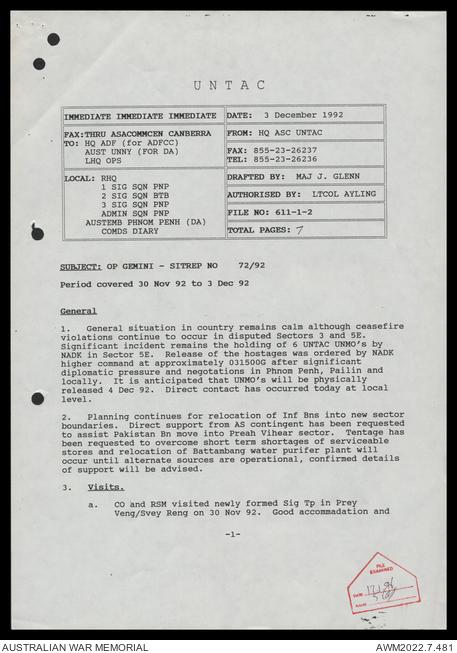Helping to make a new future
Australian peacekeeping personnel in the United Nations Transition to Authority in Cambodia mission, 1992–1993
The Memorial has digitised the commander's diaries for the Australian Service Contingent, United Nations Transitional Authority Cambodia (UNTAC) which are available online.
Australian military personnel made significant contributions to United Nations peacekeeping missions in the early 1990s. In south-east Asia the biggest mission was in Cambodia, which had been ravaged by civil war, suffered the horrors of the genocidal Khmer Rouge Pol Pot regime, endured military occupation by Vietnam, and experienced incessant poverty. In the late 1980s the Cambodian government sought assistance from the United Nations.
The United Nations negotiated the 1991 Paris Agreement, which provided for two major missions: the United Nations Advance Mission to Cambodia (UNAMIC) and the United Nations Transitional Authority in Cambodia (UNTAC).
UNAMIC was primarily a civilian advisor mission tasked with maintaining the ceasefire and training Cambodians in mine detection and clearance training. Australia provided signallers for UNAMIC, committing 65 personnel in October 1991. In March 1992 UNAMIC was absorbed by UNTAC, an armed multi-national peacekeeping force established to supervise the ceasefire and a general election. Several hundred Australian military personnel and federal police officers served with UNITAC between 1992 and 1993.
The Australian UNTAC contingent provided assistance with policing, weapons control and disarming factions, and helped create a reliable nation-wide communications network. After the election, the mission helped the newly-elected democratic government become established and manage Cambodia without the ongoing need for external assistance.
A meeting of the Mixed Military Working Group, responsible for planning and directing the UNTAC mission. Photograph by Heidi Smith.
The Australian commanders’ diaries record work undertaken during the UNTAC mission, including situation reports, maps and diagrams, guides for official visits, Mission Command meeting records, reports on rebel group activities, lists of personnel serving in Australian deployments, personnel lists of other nations’ units, sets of routine orders, standard operating procedures, and force commander’s reports to the UN.

First page of a weekly Situation Report, 1992. AWM2022.7.481
RAAF personnel assigned to the Australian-led Force Communications Unit. Photograph by Wayne Ryan.
Australian personnel selected from signal and logistics units formed the Force Communications Unit. Fax machines proved essential, as they could easily be adapted to the limited telephone networks and provide printed copies of daily communications.
An Australian signals unit soldier at the Force Communications Unit headquarters. Photograph by Heidi Smith.
Lieutenant Colonel Marty Studdert, Commanding Officer of the Australian-led Force Communications Unit from December 1992 to October 1993. Photograph by Heidi Smith.
Troops based at the main Australian camps, Pteah Australii and Pteah Kangaroo, had to deal with monsoonal weather and threats of armed action by rebel forces. Beyond the camps, experiences included assisting Cambodia’s civilian police, mine detection and disposal, and monitoring the illicit firearms trade.
Australian personnel at Battambang base camp prepare to return to Australia at end of their deployment. Photograph by Heidi Smith.
By the time the Cambodian general election took place in May 1993, voter registration was at 96 per cent, with a turnout of 90 per cent of registered voters. The 120-member assembly drafted a new constitution, which was approved on 24 September 1993. The constitution established a multi-party liberal democracy with a constitutional monarchy, and provided for a wide range of internationally recognised human rights.
The UNTAC commanders’ diaries for Australian personnel are unique documents which record the peacekeeping service and experiences of Australian military personnel. They give insights into the role of the UNTAC mission in Cambodia and provide first-hand accounts of this multinational peacekeeping operation.
These files are held as Official Record Series AWM399, “Commander's Diaries - Australian Contingent ASC - United Nations Transitional Authority Cambodia UNTAC”, with all 37 files in the series now available to view online here.




